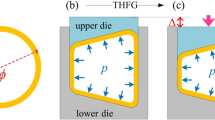Abstract
Tubular components, such as stepped tubes, conical tubes and box shape tubes, are mainly produced in tube hydroforming process. Obtaining a sharp corner is a main goal in some of these components. In this paper, the corner filling in stepped tubes is studied by a multistage new die. The proposed die was simulated and the filling of die cavity was investigated. In this respect, the finite element software, ABAQUS 6.4, has been used for simulation. In order to verify the simulation results, the new die of stepped tube was manufactured and some experiments have been performed. The results obtained from the experiments verified the simulation results. It is shown that by using the new die parts with sharp corners could be produced. The simplicity of the die and low internal pressure are another advantages of this die. The thickness distribution was also examined by both the FE simulation and experiments and it is shown that a better distribution could be obtained by the proposed die set.


















Similar content being viewed by others
References
Koc M, Allen T, Jiratheranat S, Altan T (2000) The use of FEA and design of experiments to establish design guideline for simple hydroforming parts. Int J of Mach Tools Manufact 40:2249–2266
Kim J, Kang B-S (2002) Implementation of backward tracing scheme of the FEM for design of initial tubular blank in hydroforming. J Mater Process Technol 125–126:839–848
Koc M, Altan T (2002) Application of two dimensional (2D) FEA for the tube hydroforming process. Int J of Mach Tools Manufact 42:1285–1295
Koc M, Altan T (2002) Predication of forming limits and parameters in the tube hydroforming process. Int J of Mach Tools Manufact 42:123–138
Kridli GT, Bao L, Mallick PK, Tian Y (2003) Investigation of thickness variation and corner filling in tube hydroforming. J Mater Process Technol 133:287–296
Fann K-J, Hsiao P-Y (2003) Optimization of loading conditions for tube hydroforming. J Mater Process Technol 140:520–524
Hwang Y-M, Chen W-C (2005) Analysis of tube hydroforming in a square cross-section die. Int J of Plasticity 21:1815–1833
Gang L, Shijian Y, Bugang T (2006) Analysis of thinning at the transition corner in tube hydroforming. J Mater Process Technol 177:688–691
Loh-Mousavi M, Mori K, Hayashi K, Bakhshi-Jooybari M (2007) Improvement of filling die corners in box-shaped tube hydroforming by control of wrinkling. Key Engineering Materials 334:461–467
Loh-Mousavi M, Mori K, Hayashi K, Maki S, Bakhshi M (2007) 3D finite element simulation of pulsating T-shape hydroforming of tubes. Key Eng Mater 340–341:353–358
Elyasi M, Bakhshi-Jooybari M, Gorji AH, Nourouzi S, Alinejad GM (2008) Numerical and experimental investigation on forming metallic bellows in closed and open die hydroforming. Steel Res Int 79:148–154
ABAQUS CAE 6.4 (2003) Theory Manual. Hibbit, Karlsson, Sorensen, Inc
Ngaile G, Jaeger S, Altan T (2004) Lubrication in tube hydroforming (THF) Part I. Lubrication mechanisms and development of model tests to evaluate lubricants and die coatings in the transition and expansion zones. J Mater Process Technol 146:108–115
Author information
Authors and Affiliations
Corresponding author
Rights and permissions
About this article
Cite this article
Elyasi, M., Bakhshi-Jooybari, M. & Gorji, A. A new die design for the hydroforming of stepped tubes. Int J Mater Form 3, 71–75 (2010). https://doi.org/10.1007/s12289-009-0419-7
Received:
Accepted:
Published:
Issue Date:
DOI: https://doi.org/10.1007/s12289-009-0419-7



